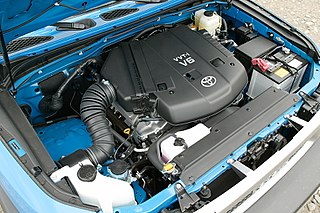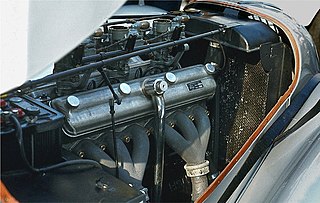
The BMW M30 is a SOHC straight-six petrol engine which was produced from 1968 to 1995. With a production run of 27 years, it is BMW's longest produced engine and was used in many car models.

The Jaguar AJ-8 is a compact DOHC V8 piston engine used in many Jaguar vehicles. It was the fourth new engine type in the history of the company. It was an in house design with work beginning before Ford's purchase of the company. In 1997 it replaced both designs previously available on Jaguar cars: the straight-6 Jaguar AJ6 engine, and the Jaguar V12 engine. It remained the only engine type available on Jaguar until 1999 with the launch of the S-Type, when the Jaguar AJ-V6 engine was added to the list. The AJ-V8 is available in displacements ranging from 3.2L to 5.0L, and a supercharged version is also produced. Ford Motor Company also used this engine in other cars, including the Lincoln LS and the 2002–2005 Ford Thunderbird, as well as in several Land Rovers, and the Aston Martin V8 Vantage.

The BMW M10 is a SOHC inline-4 petrol engine which was produced by BMW from 1962-1988. It was the company's first four-cylinder engine since the BMW 309 ended production in 1936 and was introduced in the New Class sedans.

The BMW M20 is a SOHC straight-six petrol engine which was produced from 1977 to 1993. It was introduced eight years after the larger BMW M30 straight-six engine, which remained in production alongside the M20.

The BMW M50 is a straight-6 DOHC petrol engine which was produced from 1990 to 1996. It was released in the E34 520i and 525i, to replace the M20 engine.

The BMW M52 is a straight-6 DOHC petrol engine which was produced from 1994 to 2000. It was released in the E36 320i, to replace the M50. The BMW S52 engine is a high performance variant of the M52 which powered the American and Canadian market E36 M3 from 1996 to 1999.

BMW M62 is a naturally aspirated V8 petrol engine which was produced from 1995 to 2005. A successor to the BMW M60, the M62 features an aluminium engine block and a single row timing chain.

The BMW S38 is a straight-6 DOHC petrol engine which replaced the M88 and was produced from 1984-1995. The S38 was originally produced for North America as an equivalent to the M88 with slightly lower power output. In 1989, power output of the S38 was increased and it became the worldwide replacement for the M88.

The BMW M54 is a naturally aspirated straight-6 DOHC petrol engine produced from 2000 to 2006. It was released in the E53 X5 and is the replacement for the M52 engine. The S54 is the equivalent high performance engine, used in the E46 M3, the Z3 M Coupé/Roadster and the E85/E86 Z4 M. The BMW M56 SULEV engine is based on the M54.

The BMW N62 is a naturally aspirated V8 petrol engine which was used in BMW cars from 2001–2010. It also remained in small-scale production for the Morgan Aero until 2019. The N62 is the world's first engine to use a continuously variable-length intake manifold, and BMW's first V8 to feature variable valve lift.

Toyota Motor Corporation's M family of engines were a longitudinally mounted straight-6 engine design. They were used from the 1960s through the 1990s. All M family engines were OHC designs. While the M family was born with a chain-driven single camshaft it evolved into a belt-driven DOHC system after 1980. All M family engines used a cast-iron block with an aluminum cylinder head, and were built at the Toyota Kamigo plant in Toyota City, Japan.
The Honda B20A engine series, known as the B20A and B21A, was an inline four-cylinder engine family from Honda introduced in 1985 in the second-generation Honda Prelude. Also available in the contemporary third-generation Honda Accord in the Japanese domestic market, along with the Accord-derived Vigor, the B20A was Honda's second line of multivalve DOHC inline four-cylinder engines behind the "ZC" twin-cam variant of the ordinarily SOHC D-series, focused towards performance and displacing 2.0 to 2.1 litres.
The Hyundai Alpha series is a multi-valve gasoline inline four-cylinder engine family comprising 1.3, 1.4, 1.5, and 1.6L naturally aspirated versions and a 1.5L turbocharged version. Introduced in 1992, this was Hyundai's first engine designed entirely in-house and was the first indigenous South Korean engine design. Design objectives were to provide high performance and good fuel economy with excellent durability at a reasonable cost.

The Toyota GR engine family is a gasoline, open-deck, piston V6 engine series. The GR series has a 60° die-cast aluminium block and aluminium DOHC cylinder heads. This engine series also features 4 valves per cylinder, forged steel connecting rods and crankshaft, one-piece cast camshafts, a timing chain, and a cast aluminium lower intake manifold. Some variants use multi-port fuel injection, some have D4 direct injection, and others have a combination of direct injection and multi-port fuel injection or D4-S.

The Volvo Modular Engine is a family of straight-four, straight-five, and straight-six automobile piston engines that was produced by Volvo Cars in Skövde, Sweden from 1990 until 2016. All engines feature an aluminum engine block and aluminum cylinder head, forged steel connecting rods, aluminum pistons and double overhead camshafts.

The BMW 303 was a small family saloon produced by BMW in 1933 and 1934. It was the first BMW motor car with a six-cylinder engine and the first BMW motor car with the "kidney grille" associated with the brand. The platform developed for the 303 was used for several other BMW cars, including the BMW 309, a four-cylinder version of the 303, the BMW 315, a 1.5-litre version of the 303 which replaced it in 1934 and was built until 1937, the BMW 319, a 1.9-litre version of the 303 produced alongside the 315 from 1935 to 1937, and the BMW 329, a development of the 319 with styling based on the newer, larger BMW 326, that briefly replaced the 319 in 1937.

The BMW OHV V8 is an overhead valve V8 petrol engine produced from 1954 to 1965. It is BMW's first V8 engine, and BMW did not produce another V8 automobile engine until the BMW M60 in 1992.

The BMW M328 is an overhead valve straight-six petrol internal combustion engine which was produced from 1936 to 1940. It was a high-performance development of the BMW M78 engine that was produced alongside the M78.

The BMW M337 is a straight-6 OHV petrol engine installed at a slanted angle which was produced in three variants from 1952-1958. Built to power BMW's first new car after World War II, the M337 engine was a replacement for the BMW M78.


















